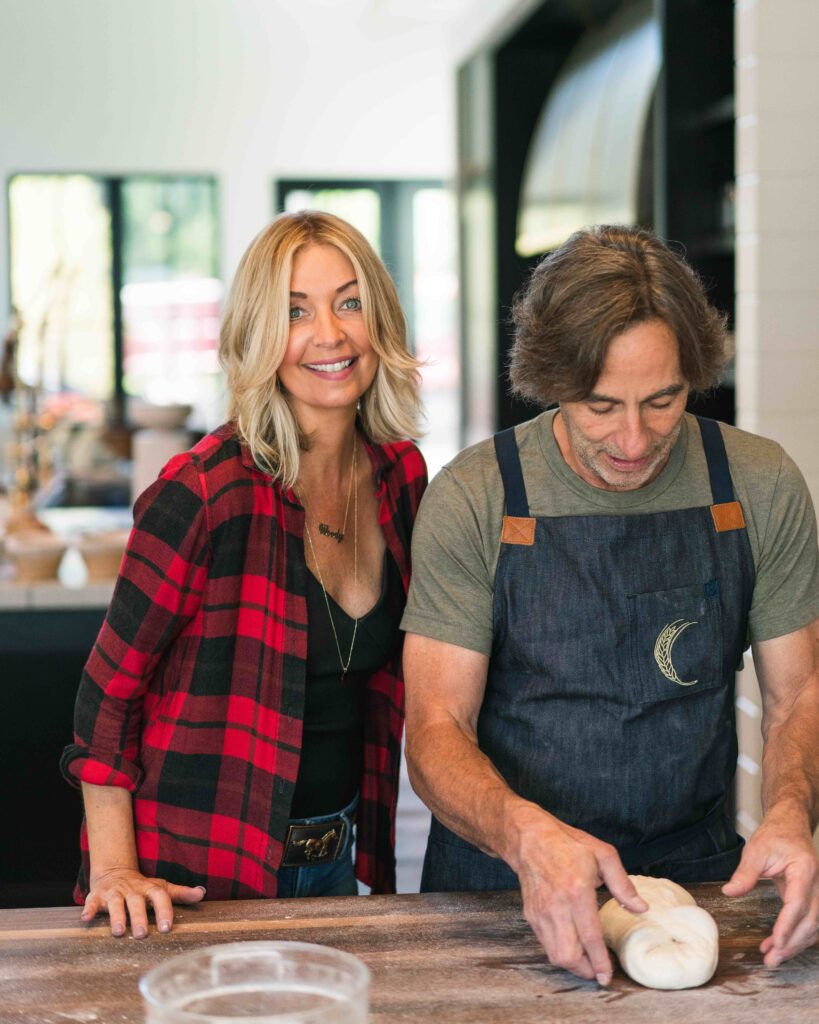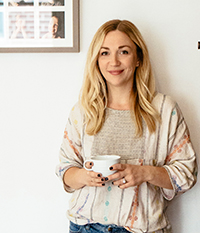If the empty flour shelves are any indication, many of us are baking like crazy during our stay-at-home order. Baking bread—and playing scientist with your sourdough starter—may seem intimidating, but it’s actually not that complicated, as long as you have the ingredients and time. Jim Challenger, who launched Challenger Breadware to help at-home and professional bakers yield the best bread with every bake, knows his sourdough (and even Martha Stewart is a fan of Challenger’s Bread Pan). We asked him for his best tips, and why he thinks everyone is drawn to the art of bread making during this time.
How did you become a baker—and eventually start Challenger Breadware?
Challenger Breadware grew organically because I was frustrated by the fact that there were no good ways to bake bread at home. Everything was just a hack. I had tried the Lodge combo cooker that is well recommended, but I could only bake small round loaves, called boules. I then tried my Le Creuset Dutch oven because I could bake bigger loaves. It’s so deep that it is close to impossible to get your dough inside without burning your hands or cutting a sling out of parchment paper every time to help.
One day on Instagram, I met Sara Dahmen. She is an old-fashioned coppersmith who works out of her garage in Wisconsin. We started talking about copper cookware, and I realized that she had created her very own cast iron skillet. A light bulb went off in my head. I asked her if she could help me create an upside-down cast iron Dutch oven that was designed from day one for baking bread in a home oven. She mentored me throughout the process, and she introduced me to her product designer and the foundry she used – both also in Wisconsin near our home in Illinois.
I was only going to make 4 pans for myself along with making 10-20 extras that I could sell to my friends on Instagram; I just wanted to recoup our investment. I gave away six prototypes to baker friends on Instagram. Well… they posted about how ecstatic they were with the results, and the emails and messages started flowing in. The interest kept growing, and we decided we had to turn this into a real business. Thus, Challenger Breadware was born.
View this post on Instagram
You bake daily. What are your tips for a first timer?
Just do it. Jump in. Make your first loaf. It’s not complicated, but bakers (like me!) can make it complicated because we have the “Curse of Knowledge.” We know too much. So, when someone asks a simple question, we often give them a complex answer and confuse them. I recently developed a recipe that I’ve been posting about on Instagram. We call the recipe, KIS Bread (Keep It Simple). Once you’ve made your first loaf, then you just have to decide if it was fun. If it was, then you make another loaf and you might wonder, “Why does it look different?” If you get to this point, then bread baking becomes so much fun because the dough is a living thing. It will be different every time, and you can learn to control it more and more and just keep making better bread. It will look prettier every time, and you can then start playing with flavors to make different breads.
You and your wife Lisa are helping the community by baking bread for others at your Blue Moons Farm outside of Chicago, Illinois. How did this come about?
There’s been an interesting side effect from the virus for Lisa and me. We’ve always made bigger batches of bread 2-3 days per week which we gave to friends and neighbors in our community. One day, Lisa texted me a picture showing the empty bread shelves at the grocery store. When she came home, we decided that we were going to make big batches of bread every day for our community. It has grown and grown, and we’ll be packaging Day 28 around noon today. It’s the most gratifying thing I’ve ever done in my life, and I realized I’m becoming a better baker!

Why do you think is so calming about baking bread?
Bread baking offers many things, especially during these troubled times. First, it is something healthy and delicious that you can make at home for your family with just three or four ingredients: flour, water, salt, and sometimes baker’s yeast – sourdough bakers make their own wild yeast out of flour and water. Second, it is a very relaxing and meditative hobby. It doesn’t take a lot of work; it just takes time. And the more present and aware you are throughout the process and the more love you give your dough, the better your bread will turn out. Finally, the process can draw you into even deeper thought if you want your loaves to turn out better and better. There are so many nuances that you can learn through passion, patience, practice and perseverance. It’s like playing a guitar, you can’t play a song the first time you pick up, but if you keep trying, you’ll just keep getting better. In twenty years, I know there will be so much more to learn and more things to bake. It’s a hobby that can last your entire life. You can make bread if you’re 8 or 80.
What common mistakes do people make?
The biggest common mistake that people make is making a recipe that’s too complex for a new baker. It is very common, and it is not talked about very much. People should start with a very easy bread that just contains white flour, water, salt, and yeast (baker’s or wild). Many recipes call for whole wheat, rye, or other flours, and these recipes will be harder. The best thing is that you could use a recipe like that but just use more white flour for the other flour that’s called for in the recipe.
The other problem is that many recipes contain too much water for a beginning baker. Once again, a beginning baker can use that recipe, but should just reduce the amount of water. It’s hard to say how much water to take away without resorting to a little math. For a beginning baker, I’d recommend looking at the total weight of the flour in the recipe and multiplying it by 65% to determine how much water to use. The intimidating part for a new baker is that they fear that if they change the flour and maybe the water too, then the bread won’t be good. Bread is always good – it doesn’t matter if you change the flour and water.
There is a shortage of supplies out there. Any tips on where to find ingredients right now?
There are so many smaller farmers and millers all over the US (and the world!) who have flour and they will ship them nationally. Check out a robust list here.
View this post on Instagram
There are many sourdough starter recipes out there it seems—some call for pineapple juice, for example. What is your favorite method?
The easiest way is to just make it with flour and water. Sourdough can be intimidating. It takes a little more thought, a little more time, and a little more care. Making bread with baker’s yeast or wild yeast is somewhat the same, but sourdough has one additional step: Your Starter. This is what sourdough bakers call their wild yeast. Like a baby, it just has to be fed more food on a regular schedule. The food is just more flour and water, and a single feeding takes less than five minutes.
Here is a favorite easy recipe by Lexie Smith of Bread on Earth:
Building a Sourdough Starter From Scratch (Read the tips first)
Day One
In a clean glass with room to spare, mix:
25g flour* see note
40g water
Cover loosely and rest for 24 hours.
Day Two
Stir lightly and add:
25g flour
50g water
Mix and cover loosely. Rest for 24 hours.
Day Three
Stir lightly and add:
25g flour
40g water
Mix and cover loosely. Rest for 24 hours.
Day Four
You should see some evidence of life (little bubbles, smells, some rise). If not, continue anyway. Stir to combine any water that may have separated. Remove 25g and place in a clean glass (discard the rest).
To this glass, add:
25g flour
40g water
Mix and cover loosely. Rest for 24 hours.
Day Five
Stir lightly and remove 15g and place in a clean glass (discard the rest).
To this glass add:
50g flour
65g water
Cover and rest for 12 hours. If you see evidence of life, begin regular feedings.
How You Can Help:
As you bake at home and safely order groceries, consider that many struggle to feed themselves and their families. Here are some organizations to support that help feed those in need.
- The Greater Chicago Food Depository
More than 700 partners across Cook County ensure that nutritious food is available all year to neighbors in need. - Northern Illinois Food Bank
Part of Feeding America, the Northern Illinois Food Bank helps solve hunger through pantries and feeding sites. - Hillside Food Pantry
Distributes food to those in need in Evanston.
More from Better:
- 18 Feel-Good Movies and TV Shows to Lift Your Spirits Right Now
- Mental Health Check: ‘How Are You?’ Becomes a Loaded Question in the Time of COVID
- 8 Delicious Spring Recipes Highlighting the Freshest In-Season Produce
 Macaire Douglas lives in the Chicago suburbs with her husband and two sons. She proudly supports Save Abandoned Babies Foundation, a Chicago-based nonprofit organization that works tirelessly to prevent the illegal abandonment of newborns nationwide. Since its inception in 2000, more than 3,600 newborns have been safely surrendered and adopted into loving homes.
Macaire Douglas lives in the Chicago suburbs with her husband and two sons. She proudly supports Save Abandoned Babies Foundation, a Chicago-based nonprofit organization that works tirelessly to prevent the illegal abandonment of newborns nationwide. Since its inception in 2000, more than 3,600 newborns have been safely surrendered and adopted into loving homes.
